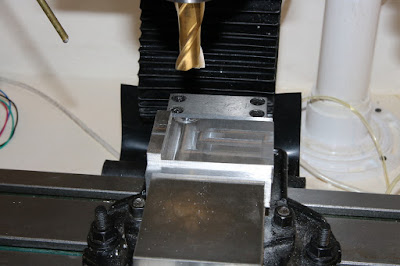It has been almost two months since I mentioned starting on a new engine, a flame licker designed by Philip Duclos. I haven't been motionless, but I haven't been spending every day in the shop either.
Life has a way of intervening and there have been plenty of unexpected side projects that took time. I've written about some of the planting. Another of those projects is that I've learned how to diagnose and repair a sprinkler system, and am in the process of getting ours back to full, normal operation. Since these come on at 4AM twice a week, I don't know that they're working or not, unless I see dried out areas in the yard. On Easter, when I was up to put the pork shoulder into the smoker at 5AM, the sprinklers were on and I could see one was simply not rotating properly. Its replacement went in Friday.
What I've done until now is cut rough stock to decent starting sizes and order some other stock I didn't have. That includes turning a 2-3/8"diameter x 3-1/4" long chunk of aluminum down to 2-1/16 diameter, cutting blocks of metal to overall dimensions needed, and that sort of mundane task. This weekend, I made the (almost ceremonial) first cuts to one of those pieces of rough stock, thinning a piece of 3/4" thick stock to the profile of the cylinder support pedestal. This is the midpoint of the process, yesterday. It took 3/16" off each side, 3/8" above one end, leaving a wider base.
The part of the support on the right is 3/8" thick now; you can see the base on the left is thicker - it's 3/4" thick. The whole piece started as bar stock that was a little over 2"x 3" x 1" thick. That's a couple of cubic inches of aluminum turned into chips in the vacuum cleaner.
Next up is to mount this to the rotary table - after I mount the rotary table. It's eventually going to resemble this:
Note that I didn't say it will look exactly like this.
Just a little shop distraction.


It is Fun to make stuff! I made a resolution to try to do one thing every day to make the shop cleaner, better, more efficient, regardless of the scope of the improvement. Anything from replacing a worn electrical cord to throwing away stuff that was "too good to throw away but not good enough to use". Today I put a second power feed on one of the shapers, so one is permanently set up for vertical (fence) work, and the other for horizontal (table) work. The machine looks like a woodworking equivalent of Edward Sissorhands". This should save about ten minutes every time the orientation needs to change.
ReplyDeleteJust for kicks the other day, I put a piece of free machining steel in the lathe, and turned a test bar 12" long. I had never checked it for accuracy before. I was pleasantly surprised to find it was under .0001 over the length- essentially perfect , or , to the limits of the measuring equipment available. It was interesting to see firsthand the difference in size of the bar between the 55 degree shop and the 72 degree house, it changed about two tenths. Pretty much just what the book says. Not bad for a 20 year old secondhand Taiwan machine.
Interesting how people approach things- I would have figured on cutting the curves on the rotary table first, most of the way though, then planing off the extra thickness. Just so a sacrificial piece would not be needed under the part on the rotary. Of course, now this introduces a clamping difficulty for the curved part,can't just put it in the vise. Are you doing this all by program, or manual?
Are you doing this all by program, or manual? .
ReplyDeleteEverything so far was manual. I’m not sure about the next parts.
I’m copying an engine from a mid-80s book, so its emphasis is handwork. Lots of Dykem and scratched lines. As the default, I’m using his methods. Instead of hand wheels on my mill, I used my RumblePad game controller. Actually works pretty well.
Should be quite nice when you're finished!
ReplyDeleteSince these come on at 4AM twice a week, I don't know that they're working or not
ReplyDeleteIs this not what video security systems are for? Set machines to watch the other machines.
How does the engine work?
ReplyDeleteIt's a little bizarre. You might want to watch a video like this one.
DeleteThe engine works on low pressure. There's a small flame - typically an alcohol lamp - that's positioned outside the cylinder. To start it, you flick the flywheel (like a manual starter), the momentum you gave it pushes the piston up toward the top of the cylinder, and when it passes over the top, a small valve opens up. The moving piston creates a lower pressure and sucks in some flame. The hot air expands and helps push the piston down to the bottom of the stroke, and adds some momentum to the flywheel. When the piston reaches its bottom, the flywheel's momentum pushes it back up toward the top, and the cycle starts over. The return force of the piston is aided by atmospheric pressure.
One of the model makers' websites says the first patent on one of these engines was granted to a Henry Wood in 1758. That predates the Otto engine by a hundred years. The Otto is generally called the first four stroke, internal combustion engine. Good summary here.
These engines are called flame eaters, flame lickers, fire eaters, and so on. They're also called vacuum engines and atmospheric engines. I like the term external combustion engine.
'Way cool. Thanks!
Delete